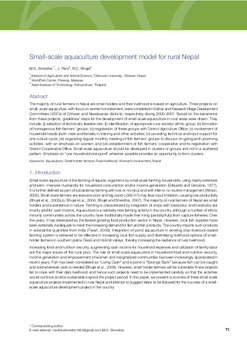Small-scale aquaculture development model for rural Nepal

Citation
Shrestha, M.K.; Pant, J.; Bhujel, R.C. (2012). Small-scale aquaculture development model for rural Nepal. p. 71-75. In: Shrestha, M.K. ; Pant, J. (eds.) Small-scale aquaculture for rural livelihoods: Proceedings of the National Symposium on Small-scale Aquaculture for Increasing Resilience of Rural Livelihoods in Nepal. Institute of Agriculture and Animal Science, Tribhuvan University, Rampur, Chitwan, Nepal, and The WorldFish Center, Penang, Malaysia
The majority of rural farmers in Nepal are small holders and their livelihood is based on agriculture. Three projects on small- scale aquaculture, with focus on women’s involvement, were completed in Kathar and Kawasoti Village Development Committees (VDCs) of Chitwan and Nawalparasi districts, respectively during 2000-2007. Based on the experience from these projects, guidelines/ steps for the development of small-scale aquaculture in rural areas were drawn. They include: (i) selection of technically feasible site; (ii) identification of appropriate rural society/ ethnic group; (iii) formation of homogenous fish farmers' groups; (iv) registration of these groups with District Agriculture Office; (v) involvement of household heads (both male and female) in training and other activities; (vi) providing technical and input support for one culture cycle; (vii) organizing regular monthly meeting of fish farmers’ groups to discuss on-going and upcoming activities, with an emphasis on women; and (viii) establishment of fish farmers’ cooperative and its registration with District Cooperative Office. Small-scale aquaculture should be developed in clusters or groups and not in a scattered pattern. Emphasis on “one household-one pond” wherever possible provides an opportunity to form clusters.
Permalink
Date Available
Type
Publisher
Countries
Copyright
CC BY 4.0
Research Themes
Language